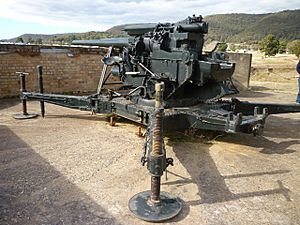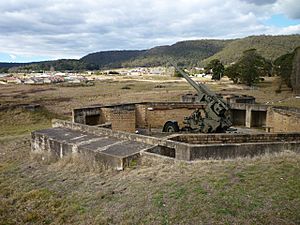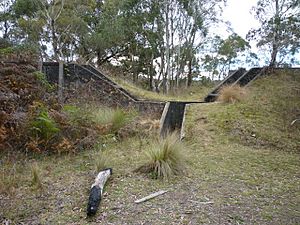Lithgow Heavy Anti Aircraft Gun Stations and Dummy Station facts for kids
Quick facts for kids Lithgow Heavy Anti Aircraft Gun Stations and Dummy Station |
|
|---|---|

Gun at Gun Battery A
|
|
| Location | via Kirkley Street, Bowenfels, City of Lithgow, New South Wales, Australia |
| Built | 1941–1942 |
| Owner | Lithgow City Council |
| Official name: Lithgow Heavy Anti Aircraft Gun Stations and Dummy Station; Lithgow Anti Aircraft Gun Emplacements; Heavy Anti Aircraft guns 3.7 inch anti aircraft guns | |
| Type | State heritage (complex / group) |
| Designated | 5 August 2011 |
| Reference no. | 1862 |
| Type | Battery |
| Category | Defence |
| Builders | Water Conservation & Irrigation Commission, Defence |
| Lua error in Module:Location_map at line 420: attempt to index field 'wikibase' (a nil value). | |
The Lithgow Heavy Anti Aircraft Gun Stations and Dummy Station is a special heritage site in Bowenfels, Australia. It used to be a place where big guns were set up to protect against air attacks during World War II. It also had "dummy" stations that looked like real ones to trick enemy planes.
These stations were built between 1941 and 1942. They are also known as the Lithgow Anti Aircraft Gun Emplacements. Today, the Lithgow City Council owns the property. It was added to the New South Wales State Heritage Register on August 5, 2011, because of its important history.
Contents
History of the Lithgow Gun Stations
Why Lithgow Needed Defenses
When Japan joined World War II in late 1941, Australia became worried about air attacks. At first, defenses were built in big cities like Sydney and Newcastle. But after Japan's quick advances, places like Lithgow also needed protection.
Lithgow was very important because it had factories and transport links. The Lithgow Small Arms Factory made weapons for the war. There were also ammunition depots and coal mines nearby. The army wanted to protect these vital places from enemy bombers and fighter planes.
Building the Gun Stations
The army decided to build two main gun stations. Each station would have four large 3.7-inch anti-aircraft guns. One station (A Troop) was placed at the western end of the Lithgow Valley in Bowenfels. The other (B Troop) was at the eastern end on Scenic Hill. This was because planes would likely attack from either end of the valley.
Work started very quickly in December 1941. Concrete floors were poured for the gun positions. The guns were supposed to arrive sooner, but they were sent to Singapore instead. This delayed their arrival in Lithgow until early 1942.
How the Guns Worked
The guns were protected by strong concrete walls called revetments. These walls also held ammunition and kept the gunners safe from bombs.
Each gun station had a central building called a Command Post. This building was like a small fort. Inside, there were special tools to help aim the guns. One tool was called a Predictor. It was like an early computer. It figured out how fast enemy planes were flying and where they were going. This information helped the gunners know when and where to shoot.
The gun stations were connected to the army headquarters in Lithgow. By January 1942, both stations were ready for action.
Dummy Stations and Later Years
To further protect Lithgow, "dummy" gun emplacements were built. These looked like real gun sites from the air. They were meant to trick enemy pilots into bombing empty areas instead of the actual gun stations.
As the war moved further north, the threat to Lithgow decreased. The guns were removed from the stations in late 1943 and early 1944. They were likely sent to islands north of Australia. After the war, the fake buildings at the dummy sites were sold off.
In 2003, three anti-aircraft guns were brought back to the Bowenfels Gun Station. These guns are similar to the original ones. The site was also cleaned up so people could visit it.
Anti-Aircraft Guns in World War II
During World War II, over 100 anti-aircraft gun sites were set up across Australia. About 30 were in New South Wales, mostly along the coast. The Lithgow sites were special because they were the only ones located west of the Blue Mountains.
Heavy anti-aircraft guns were used to shoot down planes flying high in the sky. The 3.7-inch gun was a common type. It could fire a 22-kilogram (49 lb) shell up to 7,600 metres (25,000 ft) high. These guns could fire 12 to 15 rounds per minute.
Most of these static (fixed to the ground) guns were removed after the war. Only two original static 3.7-inch guns are known to exist today in Australia. They are at North Head in Sydney. The mobile guns at South Bowenfels are the largest collection of their type in New South Wales.
Description of the Sites
The Lithgow Anti Aircraft Gun Stations are in different kinds of places. The Bowenfels Gun Station is in a large, open area. You can see mountains in the distance. The Great Western Highway is also nearby.
The Scenic Hill station is in a more isolated, bushy area. Its dummy gun station is even deeper in the bush.
Both stations have four round concrete areas where the guns sat. These are called gun emplacements. They are built around a central concrete command bunker. This bunker is a square, three-level building connected to a smaller round building.
Gun Emplacements
Each gun emplacement is designed for a 3.7-inch anti-aircraft gun. They have thick concrete walls. Inside these walls are storage areas for ammunition. These areas also protected the gunners from bomb blasts. You can still see the bolts in the center of each emplacement where the guns were fixed.
Command Post Bunker
The command post bunker is a strong, concrete building. It has different rooms and narrow passages that connect them. The two smaller buildings on top had platforms for the tracking instruments. One was for the Predictor, and the other for the height finder and telescope. These platforms had roofs that could open when the guns were needed.
Current Condition
The Bowenfels gun station is in good condition. It has been cleaned and made easy to visit. Three mobile 3.7-inch anti-aircraft guns have been placed in three of its emplacements. They look good but need ongoing care to prevent rust.
The Scenic Hill gun station is not in as good condition. It has partly collapsed in some areas, and nature is slowly taking it over. The dummy battery emplacements are also showing signs of wear and tear.
Heritage Listing
The Lithgow Anti Aircraft Gun Stations and Dummy Station are very important to the history of New South Wales. They are the only known inland heavy anti-aircraft gun stations of their kind in the state.
They show how Australia's defense plans changed during World War II. When Japan entered the war, there was a greater fear of attacks on inland areas. These stations were built to protect Lithgow's important factories, mines, and transport links. The dummy batteries also show how the army tried to protect these sites by tricking the enemy.
The Bowenfels Anti Aircraft Gun Station is also important to the local community. Many people in Lithgow care about the site. They help look after it and take part in events there.
These sites also offer a lot of information for researchers. They can help us understand how these defense sites were designed and built. They also show how they fit into the larger network of defense sites during World War II.
The Lithgow Heavy Anti Aircraft Gun Stations and Dummy Station were officially listed on the New South Wales State Heritage Register on August 5, 2011.





